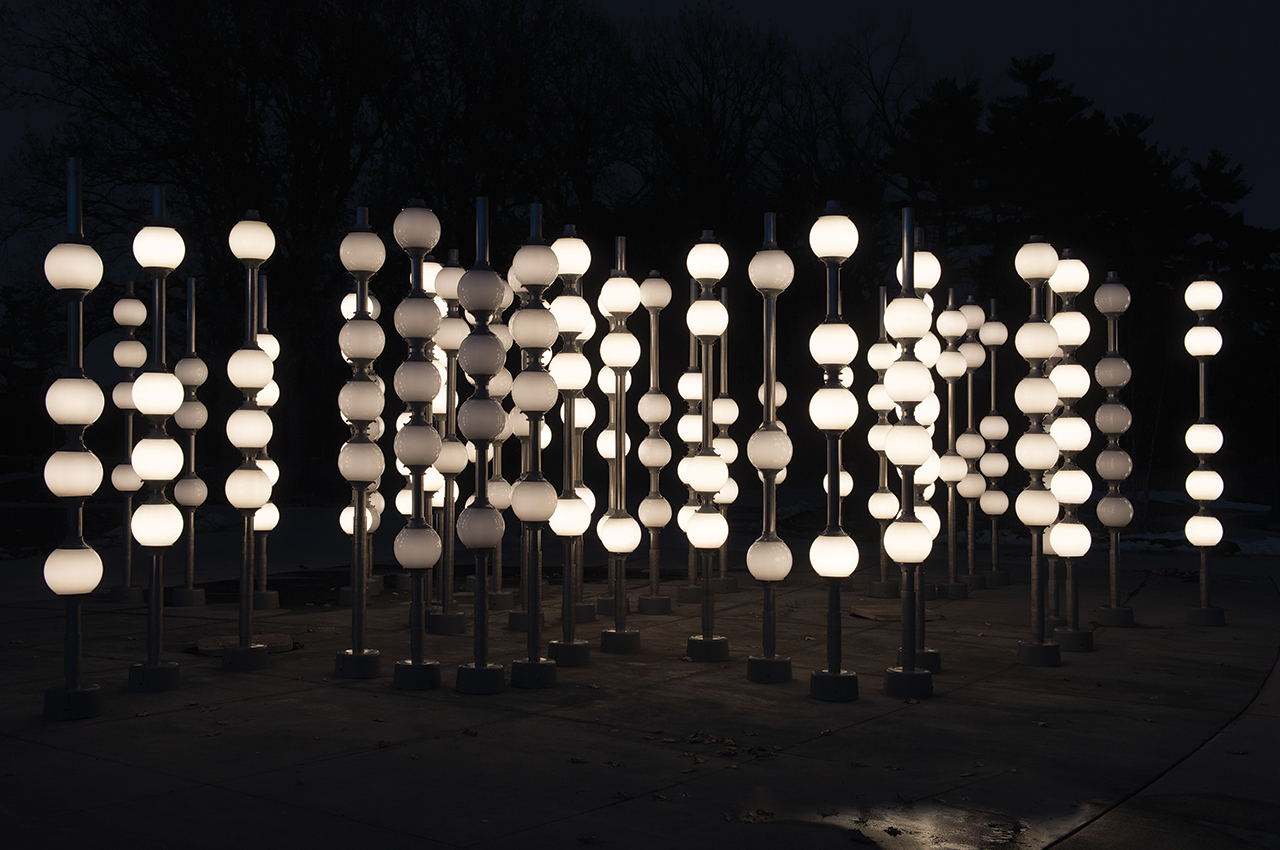Above: Hung at various heights in a thicket of 10-foot-tall steel poles, the installation’s illuminated polycarbonate orbs light the night.
Writer: Michael Morain
Photographer: Duane Tinkey

For thousands of years, stargazers have scanned the skies for new discoveries way out in the unthinkable distance.
But now, they can set their sights closer to home. An ethereal new sculpture called “River Constellation” was installed this past November in Water Works Park, just south of the new Lauridsen Amphitheater near Fleur Drive.
About 200 illuminated polycarbonate orbs are hung at various heights in a thicket of 45 10-foot-tall steel poles anchored in concrete. Visitors can wander among the poles that loosely replicate the flowing path of the Raccoon and Des Moines rivers—as if floating with the current or, perhaps, through the Milky Way.
“We [wanted] to create a sense of intimacy in a vast space and the other way around,” the New York sculptor Natalia Zubko says.
Zubko dreamed up the project with the composer Beau Kenyon, a Creston native who recently moved from Boston to Des Moines. “We want viewers to get lost in the sound and light,” Kenyon says. “We want the experience to feel communal but also individual and meditative and peaceful.”
Kenyon recorded original music, featuring members of Des Moines Metro Opera and the Des Moines Symphony, and blended it with birdsongs from the park. The sound fades in and out from discreet speakers.
“I come from a classical composition background and have recently been experimenting with new ways to engage with sound,” he says. “This particular method of composition marries sound art with more traditional composition techniques to create an original new sound work.”
Project Challenges
Zubko and Kenyon have teamed up for several other projects, including interactive sound sculptures in Boston and on Governors Island, in the New York City harbor. But their project in Des Moines involved a unique set of challenges.
It has to withstand floods, like the one that washed through the park last spring. It should be easy to clean. Its technical components need to be durable and self-sustaining.
What’s more, the Water Works Park Foundation wanted the artwork to honor the park’s donors as well as those who were memorialized by the approximately 180 crab apple trees that workers removed to make way for the park’s latest
changes. In all, the $13 million transformation includes the two-sided amphitheater that can accommodate crowds of 17,000 or more; a 30-acre lawn for picnics and games; a plaza for exhibitor booths and food trucks; two playgrounds; restrooms; and a tunnel to Gray’s Lake.
Kenyon and Zubko rose to the challenge. Their proposal was chosen from a nationwide search conducted by Group Creative Services, a local arts-consulting company led by Teva Dawson and Mat Greiner.
“If you involve artists in the process early on, you’ll often end up with very different results,” Greiner says. “Artists don’t look at problems as things they can’t solve. They’re used to using odd collections of resources to solve problems with distinction and novelty and innovation.”

Memorial and Donor Rings
For this project, the selection committee included several people who had purchased some of the crab apple trees that were removed. Committee member Tricia Drake, for example, works at Homesteaders Life Co., which had purchased a tree for an employee who had lost an infant daughter. The family often visited their daughter’s tree, especially since her gravesite was out of town.
“I was just really sad when I realized how many trees would be taken out,” Drake says.
But crab apples don’t live forever, and they’re not suited to floods. After the 180 trees were removed, the Water Works Park Foundation sent each memorial nameplate to the corresponding family, along with a new sapling they could plant on their own property.
All of the memorial names are etched onto rings at the bottom of each pole. So “while it doesn’t replace the trees, it’s still a place to go,” Drake says. “It’s still a memorial, and it’s connected to nature.”
“It’s our version of the plaques on the bridge” across Gray’s Lake, says Sam Carrell, Water Works Park Foundation executive director.
The names of donors also are etched on the rings. The $250,000 artwork was funded privately by the Krause family and other donors. More than 300 blank rings are available for the names of future donors.
The focus on individuals who make up a community is one of the installation’s central themes. Zubko and Kenyon hope visitors will remember those who helped create the park and consider how they themselves can protect its future, one small step at a time.
The artists were guided by a Japanese proverb: If it piles up, even dust can become a mountain.











